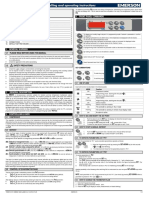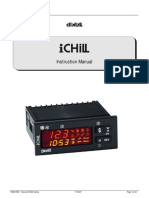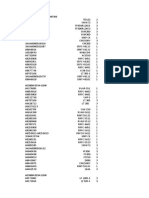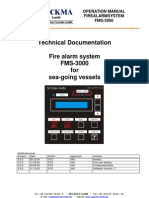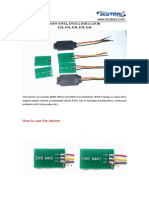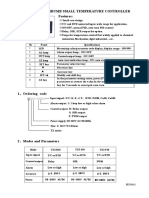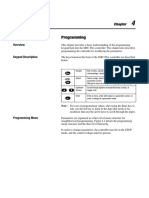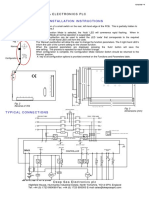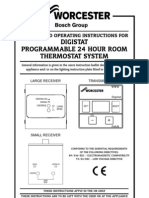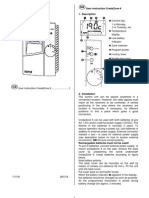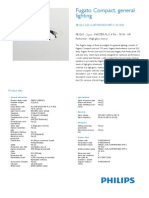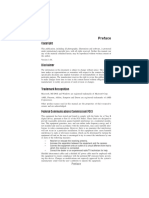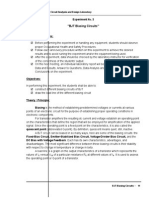Manual Roca RX 100
Manual Roca RX 100
Uploaded by
Mile BlaževićCopyright:
Available Formats
Manual Roca RX 100
Manual Roca RX 100
Uploaded by
Mile BlaževićCopyright
Available Formats
Share this document
Did you find this document useful?
Is this content inappropriate?
Copyright:
Available Formats
Manual Roca RX 100
Manual Roca RX 100
Uploaded by
Mile BlaževićCopyright:
Available Formats
RX-100
Termostato Inalmbrico Programable
Instrucciones de Instalacin, Montaje y Funcionamiento para el INSTALADOR Y USUARIO GB
Drahtloser Programmierbarber Thermostat
Betriebs-, Reinigungsund Wartungsanleitung fr den INSTALLATEUR und den BENUTZER I
Wireless Programmable Thermostat
Installation, Assembly and Operating Instructions for the INSTALLER and the USER
Cronotermostato Senza Fili
Istruzioni per lInstallazione, il Montaggio e il Funzionamento per lINSTALLATORE e per UTENTE P Instrues de Instalao, Montagem e Funcionamento para o INSTALADOR e UTENTE
F Instructions dInstallation, de Montage et Fonctionnement pour lINSTALLER et lUTILISATEUR
Thermostat dAmbiance Sans Fil Programmable Termostato Sem Fios Progrmavel
GB
3. STARTING UP
3.1 Fitting the batteries Three (3) alkaline 1.5 V batteries, type LR 03 or AAA (with a life of more than 1 year). Do not use rechargeable batteries.
Press . The green "OK" light comes on. The receiver is configured. 3. To exit the configuration mode. The red light indicates the condition of the output contact. Lit = Closed Out = Open 3.5 Checking the radio transmission To check the quality of the radio transmission, press (3 seconds) until the screen shown is obtained. The transmitter sends information to the receiver.
1. CHARACTERISTICS
- Powered by three 1.5 V alkaline batteries, type LR 03 or AAA (supplied), with a life of more than a year. Low-battery indication. - Integral proportional regulation (Category B), time base 15 minutes. - Five (5) fixed programmes and 1 personal programme (per day) for each day. - Two (2) adjustable temperatures (from 5C to 30C) for programming. - Manual programme override: Possibility of choosing a temperature between 5C and 30C until the next change of programme. - Absence mode: Possibility of choosing a temperature between 5C and 15C due to absence from the home (from 1 to 99 days or permanent). - Digital display. - Sliding door for access to programming keys. - Overall dimensions of box: 110 x 82 x 32 mm. - Wall-fitted or on the stand provided. - Transmission frequency: 433 MHz. - Class Ii insulation. - Apparatus conforms to EEC Directive 89/336. - Transmission of the On/Off arder every 15 minutes or in a change of state of the regulation.
Fig.2
Fig.3 The yellow light on the receiver flashes in time to the transmissions. The transmission is perfect if the green "OK" light flashes 3 times for each reception ofs information. 3.6 lf a problem exists lf the green "OK" light flashes rapiclly, it means that the receiver has received no information for more than an hour. 1) Check the transmitter batteries. 2) Enter the configuration mode. (para. 3.4).
To fit the batteries, remove the back cover (Fig. 2) and insert the batteries, being careful to respect the polarity (Fig. 3). * Changing batteries When the low battety indicator appears on the screen, the batteries should be replaced since deterioration of the batteries could cause internal damage to the apparatus. You have 2 minutes to replace the batteries without loss of memory in the apparatus (programme and temperature). 3.2 Quick help label There is a summary of all the operations for normal use on a self-adhesive label supplied with the apparatus. This label can be stuck on the back of the sliding door. 3.3 Setting the time 1. 2. 3. 4. 5. 6. 7. or Day setting (C) (e.g. 1 = Monday) or Minute setting (B) or Hour setting (A)
2. INSTALUTION
2.1 General Radio waves are propagated in the same way as light, in straight lines. lndoors the waves are reflected and weakened by obstacles in their path. 2.2 lnstallation For correct operation of the programme it is necessary to situate the transmitter in a place that is thermally representative of the room, avoiding corners, proximity to doors and Windows, as well as by the sun, chimneys, radiators,.. The recommended height is 1.5 metres from the floor. The transmitter can be regarded as a remote control for the central heating, that follows the user aming to where he is at each moment (in the kitchen, ding-room, bedroom) with the objective of constantly having the most suitable temperature. 2.2.1 Wall-mounting To fit the transmitter on a Wall, it is necessary to remove the back cover as shown in Fig. 1. Once the back cover is removed from the thermostat, it should be fixed to the wall using the indicated holes 1. (Fig. 1). Fig.1
on the receiver does not flash, lf the yellow light move the transmitter about until flashing occurs. lf the yellow light on the receiver flashes and the green "OK" light does not flash (3 times) for each reception of information, reconfigure both apparatuses (para. 3.4) NOTE Pressing the key changes the condition of the output contact (manual adjustment) until the next transmision form the thermostat (which always has priority).
OK Star clock
4. OPERATION
1 Days of the week 2 Cancel the automatic programme 3 Long-term absence 4 Time 5 Central Heating temperature 6 State of output relay ( = lit) 7 Low-battery indicator 8 Temperature value 9 Measured temperature 10 Daily programme outline = Economy = Comfort) 11 Adjustment keys 12 Validation 13 Keys behind the door 14 Comfort or Configuration 15 Economy (Night Setback) or Test 16 Cancel 17 Setting the time 18 Consulting or adjusting the weekly programme 19 Absence key
3.4 Configuration / Reconfiguration Each receiver has its own particular transmitter. This mode of configuration allows the pairing of the receiver with a transmitter (so there is no interferente from nearby installations). lt also allows verification of the radio transmission. Configuration is done in 2 stages: 1. (3 seconds) until the shown screen is obtained. The transmitter sends information to the receiver.
2.2.2 Fitting on the stand The thermostat can be placed on a side-board or table by inserting the clips of the stand in the holes (1) in the back cover, as shown in the diagram. The aforementioned transmitting and thermal conditions for the chosen situation should not be forgotten.
on the receiver 2. The flashing yellow light confirms reception of the information. *lf the green "OK" light is lit and steadx the receiver is already configured. To reconfigure it, press for 10 seconds until the green "OK" light flashes slowly, then release. Press once more. The green "OK" fight is steady and the receiver is reconfigured. *lf the green "OK" light flashes slowly the receiver is not configured.
6.1 Selecting the weekly programme DAY 1 Example P4 Users choice Help can be obtained from the following grid before choosing a specific programme P = in the apparatus. Example: 3rd day Day 3 Day 1 = 19C (Comfort) = 15C (Night Setback) A sliding door gives access to the programming keys. The method used is simple and always the same: - Select the function by pressing the corresponding key. - Seleci the desired value with the - Validate the choice with or keys. Day 2 Day 3 Day 4 Day 5 Day 6 Day 7 6.2 Storing or Alteting the programmes 1. 2. Consult day 1 (e.g. Monday) or Choice of programme to be assigned to this day (e.g. P5) Following day Repeat operations 2 and 3 for each day. 2 P4 3 P= 4 P4 5 P4 6 P3 7 P3
7. SUSPENSION OF THE AUTOMATIC PROGRAMME
7.1 Override Permits adopting a chosen temperature (from 5C to 30C) until the next programmed change of temperature and therefore without modification of the programmed temperature (priority function). 1. Press or to choose the temperature (e.g. 21C) 2. Temperature of 21C programmed until the next programmed change of temperature. To cancel this mode. 7.2 Long-term absence In case of a prolonged absence, a temperature (from 5C to 30C) can be set for an indeterminate or determined number of days (from 1 to 99). 1. Press 2. There are two possibilities * Indeterminate duration The temperature on the screen flashes. Adjust with the or keys (e.g. 8.5C)
This thermostat ensures accurate control of the temperature in accordance with the rhythm of daily life. Programming example:
or exit with.
Automatic control of the central heating system by the apparatus can be suspended at any moment, for example to set a specific temperature for a given time (para. 8).
5. TEMPERATURE CONTROL
Night Setback (Economy) and Comfort temperatures can be set between 5C and 30C. These temperatures can be changed at any time. * Putting hto operation Night Setback temperature and Comfort 1. 2. 3. 4. 5. 6. or for setting the Comfort temperature or for setting the Night Setback temperature = 15C = 19C.
The temperature on the screen remains fixed and has been set for an indeterminate period. * Fixed duration
3.
Set the number of days with the
or
keys.
4. After assigning a programme to day 7, press Selection of the programme for day 7 is validated. Return to normal screen. * lf the programme chosen is P = (e.g. for Thursday) Choose the programme yourself, entering the desired temperature for each unit of 1 hour. * The first hour unit flashes. To obtain an hour of Economy (Night Setback), or For an hour of Comfort. The next hour unit flashes: repeat the operation for each hour unit. Press for the first day and go on to the next day. 4.
Example: Leaving on 10 th January, returning on 19 th January - 09 daysshould be entered. Programmed automatic operation will restart on 19 th January at 0h 00'. The temperature on the screen flashes. 3. Press or to set the
6. WEEKLY PROGRAMME
Weekly programming consists of assigning a weekly programme (1 from 6) to each day of the week. Programmes P1 to P5 cannot be altered. lt is possible to choose a personal daily programme for each day (P=). The factory setting assign programme 3 to each day by default.
temperature (e.g. 7C) The countdown begins. To cancel this mode (e.g. on returning home before the date).
1 Personal programme P = for each day.
RX-100 Thermostat Receiver
GB
1 PRESENTATION
Receiver This thermostat is a receiver that incorporates a relay with exterior antenna. The receiver is linked to a transmitter (thermostat) by means of a communications protocol for remote control. The key perrnits configuration of the receiver or temporary suspension of automatic operation (Override). The status of the output relay, as well as the proper operation of the transmission can be seen on the upper part of the receiver. 3.2 Fitting
YES
Boiler
Receiver wire: (Max. 0.75 mm2) BLUE = NEUTRAL BROWN = LIVE 2 x BLACK = BOILER AMBIENT THERMOSTAT
Receiver
NO
Blue Brown Black Black
A.T.
1. Examine the place where you are going to install the receiver. The red light indicates the contact condition of the boiler connection. Lit = "ON"; Out = "OFF". The yellow light indicates reception of the radio transmission. The green light "OK" indicates correct transmitter operation. 2.lf you are using the adhesive tape on the rear, carefully remove all dust from the surface where you are putting the receiver and then press hard. 3.lf you are using the clips, fit them as shown in the diagram below:
Usually the connection for the boiler ambient thermostat carries a jumper which should be removed before connecting the two corresponding wires. In the boiler remove the jumper and connect the two black wires across the terminals of the two corresponding contacts.
jumper
2 CHARACTERISTICS
Power supply 230V 5OHz Power consumption 1.5VA Dry contact work output 8A, 230 V Cos = 1 Four-conductor cable (4 x 0.75 mm2) Relay contact opens after one hour without radio reception. Display of correct operation of the transmitter and relay status. 1 key for overriding the automatic control and configuring the apparatus. Minimum distance between 2 receivers: 2 metres. Average range: 80 metres in open air, 20 metres indoors. Fitting: by clips or adhesive tape (on the rear). Exterior antenna supplied for fitting in the bracket opening . Dimensions: 170 x 50 x 25 mm. Reception frequency 433MHz (Standard l-ETS 300 220). IP 40. Working temperature: 0 C to 40 C Storage temperature: -10 C to 70 C Class ll insulation. This apparatus conforms to EEC Directive 89/339 (Electromagnetic Compatibility) and EEC 73/23 (Low Voltage). 4.Mark the position of the holes on the Wall. Use a 4 mm diam. drill. 5.Switch off the power supply and connect the apparatus (para. 4). 3.3 Fitting the antenna lnsert the cable in the rigid plastic protector for the antenna and then insert the protector in the hale until it stops and remains fixed.
5 STARTING UP
Radio waves are propagated in the same way as light, in straight lines. lndoors the waves are reflected and weakened by obstacles in their path. 5.1 Configuration / Reconfiguration Each receiver has its own corresponding transmitter. This mode of configuration permits the pairing of the receiver with a transmitter (so there is no conflict with neighbouring installations). The procedure is explained in the instructions for the transmitter. 5.2 Checking the transmission
4 CONNECTION
4.1 Electrical connections Before doing anything, switch off the electricity supply. Of the wires in the receiver, 2 should be connected to the live and neutral of the electricity supply and 2 to the connection for the boiler ambient thermostat, as shown:
Use the test mode to check the configuration of the system and the quality of transmission. (See transmitter instruction) 5.3 Reception problems lf the green "OK" light flashes, it means that the receiver has received no information for more than an hour (and has left the relay open). Therefore, a communication problem exists between the transmitter and the receiver.
3 INSTALLATION
3. 1 Location The receiver must be placed high up. The antenna of the receiver must be kept away from other conductors (electricity cables, metal surfaces).
1.Check the batteries in the transmitter. 2. Enter the transmission test mode (see transmitter instruction). - lf the yellow light on the receiver does not flash, move the receiver about until flashing is obtained. - lf the yellow light on the receiver flashes and the green "OK" light does not flash (3 times) for each reception of information, reconfigure both apparatuses. (See 5.1).
NOTE: On pressing the key of the receiver, the output condition of the relay is modified until the next transmission from the thermostat (which always has priority). In this case the red light keeps flashing. lf the transmission is interrupted, the receiver maintains the last running or stopping order given by the transmitter.
R-6755-0-1297-CE
Roca Calefaccin, S.L. Barcelona, 2002
You might also like
- Service Manual Daikin Altherma LT-DDocument160 pagesService Manual Daikin Altherma LT-DSlobodan GerićNo ratings yet
- Dixell XM664K PDFDocument6 pagesDixell XM664K PDFIng. Nahum Cesar Hernandez SorianoNo ratings yet
- AlphaCom E - System Management and OperationDocument54 pagesAlphaCom E - System Management and OperationNarcis PatrascuNo ratings yet
- Multi-Instrument With Control and Protection: TYPE SPG-120/10Document12 pagesMulti-Instrument With Control and Protection: TYPE SPG-120/10Muhammad SulaniNo ratings yet
- BIODOM 27 C5 DF Installation Manual PDFDocument61 pagesBIODOM 27 C5 DF Installation Manual PDFavale001No ratings yet
- MH-012 Ecomaster Clima User Manual PDFDocument7 pagesMH-012 Ecomaster Clima User Manual PDFДмитро ДзюбаNo ratings yet
- Manual Controlador Lae MTR 6Document3 pagesManual Controlador Lae MTR 6Anonymous 6VCG1YRd100% (2)
- 6es7 151 1aa04 Oabo Et 200s Im 151 1 Profibus DP Siemens ManualDocument650 pages6es7 151 1aa04 Oabo Et 200s Im 151 1 Profibus DP Siemens ManualRowell AutomationNo ratings yet
- Service Manual HSU-18 22HVA103R2DB-SM071230Document141 pagesService Manual HSU-18 22HVA103R2DB-SM071230AdrianHomescu100% (1)
- UC300 Users GuideDocument19 pagesUC300 Users Guidedreman13No ratings yet
- TYBOX H en OriginalDocument2 pagesTYBOX H en OriginalNunoArturNo ratings yet
- Iso 22301 Business Continuity Management PDFDocument13 pagesIso 22301 Business Continuity Management PDFdexi100% (3)
- C-417EM m-GARD 10Document28 pagesC-417EM m-GARD 10JoseVela82No ratings yet
- IchillDocument40 pagesIchillluis andres Herrera100% (1)
- Gen Set Controller GC 1f 2Document13 pagesGen Set Controller GC 1f 2Luis Campagnoli100% (2)
- Manuale Vega Mkii EngDocument25 pagesManuale Vega Mkii Engricardo daccacheNo ratings yet
- Top TronicDocument4 pagesTop TronicJames FergusonNo ratings yet
- Multi Air Conditioner: SVC MANUAL (General)Document136 pagesMulti Air Conditioner: SVC MANUAL (General)mikintosNo ratings yet
- GC310Document4 pagesGC310muhammad arif100% (1)
- Mini Mk7 MM GuideDocument98 pagesMini Mk7 MM GuideSebastianCastilloNo ratings yet
- For New Designs: AOZ1033AIDocument15 pagesFor New Designs: AOZ1033AIPaulo Roberto s freireNo ratings yet
- AF-60 Programming (FR)Document71 pagesAF-60 Programming (FR)Zouhair IguerhzifenNo ratings yet
- TK103 GPS Tracker User ManualDocument11 pagesTK103 GPS Tracker User ManualCarlos CastilloNo ratings yet
- Cold Pak 100: Introduction Manual To The Cp-100Document32 pagesCold Pak 100: Introduction Manual To The Cp-100LaurentEunice100% (1)
- Ice 2a265Document35 pagesIce 2a265Marcio EmersonNo ratings yet
- ITSAT-062-03 Ecomaster Clima II Software UpdateDocument6 pagesITSAT-062-03 Ecomaster Clima II Software UpdateДмитро ДзюбаNo ratings yet
- User Manual Climate Controller KR494 Version Without Roof-Top HeatingDocument7 pagesUser Manual Climate Controller KR494 Version Without Roof-Top HeatingVladimirNo ratings yet
- Gen Set Control Unit: Automatic Mains Failure Genset ControllerDocument2 pagesGen Set Control Unit: Automatic Mains Failure Genset Controllermuhammad arif100% (1)
- Abb Servi̇s Çanta Malzemeleri̇ 2021Document4 pagesAbb Servi̇s Çanta Malzemeleri̇ 2021Hasan Yiğit Demir100% (1)
- EPC-12 User ManualDocument16 pagesEPC-12 User Manualnebiyou100% (1)
- 12 DaewooDocument35 pages12 DaewooĐình Tú VũNo ratings yet
- Manual FMS3000-Eng Software 1.7Document43 pagesManual FMS3000-Eng Software 1.7Rahat AliNo ratings yet
- Instruction Manual (Window Wiper)Document15 pagesInstruction Manual (Window Wiper)Arlindo J LopesNo ratings yet
- 3505021-Bmw Ews2 Ews3 2 Emulator User ManualDocument4 pages3505021-Bmw Ews2 Ews3 2 Emulator User ManualSutiknoNo ratings yet
- TX3 Series Small Temperature ControllerDocument4 pagesTX3 Series Small Temperature Controllergruja57No ratings yet
- Manual English SMC FLEXDocument24 pagesManual English SMC FLEXMagnoNo ratings yet
- Gefran 1000 1101 Pid Controller ManualDocument19 pagesGefran 1000 1101 Pid Controller ManualCristian Godoy VargasNo ratings yet
- IA NT Operators Guide 02 2009Document8 pagesIA NT Operators Guide 02 2009Marko StubeljNo ratings yet
- QP-3HB Series: Dimension (MM)Document2 pagesQP-3HB Series: Dimension (MM)danila99No ratings yet
- XMT-5000 .CHIN 온도계Document4 pagesXMT-5000 .CHIN 온도계Nather Alusofy0% (1)
- Detector de Fumaça ZEOS-C-S - ManualDocument2 pagesDetector de Fumaça ZEOS-C-S - ManualCarlos Cesar Silva Filho100% (2)
- Schema Electrique 9N ECOMASTER BASIC 2007Document1 pageSchema Electrique 9N ECOMASTER BASIC 2007Abdelhak EzNo ratings yet
- Installation Instructions: Viper 2000 Control SystemDocument6 pagesInstallation Instructions: Viper 2000 Control SystemExtrat poisNo ratings yet
- Ziehl Abegg Users Manual FANselect en enDocument66 pagesZiehl Abegg Users Manual FANselect en encahya303No ratings yet
- 704 Installation Instructions: NormalDocument2 pages704 Installation Instructions: NormalEzequielNo ratings yet
- Siemens Loa24.171b27 Programador QuemadoresDocument20 pagesSiemens Loa24.171b27 Programador Quemadoresgerman rozo cortesNo ratings yet
- Zephyr 20S Spare Parts ManualDocument42 pagesZephyr 20S Spare Parts Manualmircomirco100% (1)
- Digital Counter/Timer Digital Counter/Timer Digital Counter/Timer Digital Counter/Timer DHC10J DHC10J DHC10J DHC10JDocument2 pagesDigital Counter/Timer Digital Counter/Timer Digital Counter/Timer Digital Counter/Timer DHC10J DHC10J DHC10J DHC10JMira BkhNo ratings yet
- Setup: Deep Sea Electronics Dse857 Usb - Rs485 Converter Installation InstructionsDocument2 pagesSetup: Deep Sea Electronics Dse857 Usb - Rs485 Converter Installation InstructionsYaseen SagarNo ratings yet
- TYPE ATS-050: Switching Control UnitDocument8 pagesTYPE ATS-050: Switching Control UnitAhmed El-AdawyNo ratings yet
- Fig. 182 - Motormaster V P50 Fault Code Display: Manual ControlDocument2 pagesFig. 182 - Motormaster V P50 Fault Code Display: Manual ControlVelmar diseño y construccionNo ratings yet
- Renault Can Clip ReprogrammingDocument8 pagesRenault Can Clip ReprogrammingHans ZehnderNo ratings yet
- TankMaster WinSetup - User's GuideDocument278 pagesTankMaster WinSetup - User's GuideSantiago OrtizNo ratings yet
- Rzasg-M2 (7) v1b Databook Eeden17 New DaikinDocument37 pagesRzasg-M2 (7) v1b Databook Eeden17 New DaikinTheEngineer - المهندسNo ratings yet
- Catalogue FX03 enDocument2 pagesCatalogue FX03 enonur_guzel6403100% (1)
- ADR833En112 PDFDocument6 pagesADR833En112 PDFJoseph BoshehNo ratings yet
- Headlight Washer System: Current Flow DiagramDocument3 pagesHeadlight Washer System: Current Flow DiagramLtBesimNo ratings yet
- Webasto Thermo-Top-C Datasheet enDocument2 pagesWebasto Thermo-Top-C Datasheet enT Sky100% (1)
- Digistat RF3 InstructionsDocument4 pagesDigistat RF3 InstructionsAnt HarrisonNo ratings yet
- Prog Digistat 24 HR 8716145055Document11 pagesProg Digistat 24 HR 8716145055James SkinnerNo ratings yet
- WT-11 7days Programmable With Furface Mounting ReceiverDocument4 pagesWT-11 7days Programmable With Furface Mounting ReceiverGoran StokiNo ratings yet
- Credazone 6 GiudeDocument3 pagesCredazone 6 Giudeguddu84No ratings yet
- Astm A529 1975Document4 pagesAstm A529 1975dharlanuctcomNo ratings yet
- Introducing Mentum Planet 5.4 - PresentationDocument58 pagesIntroducing Mentum Planet 5.4 - Presentationsepe999No ratings yet
- Advance Java Technology Question BankDocument6 pagesAdvance Java Technology Question BankdaminshahNo ratings yet
- T Rec K.26 200804 I!!pdf eDocument8 pagesT Rec K.26 200804 I!!pdf ejmrs7322No ratings yet
- Fugato Compact, General Lighting: FBS261 2xPL-C/4P18W/830 HFP C W WHDocument3 pagesFugato Compact, General Lighting: FBS261 2xPL-C/4P18W/830 HFP C W WHDaniel AlonsoNo ratings yet
- BS EN 16907-5 Earthworks Quality ControlDocument22 pagesBS EN 16907-5 Earthworks Quality Controljohn.hughesNo ratings yet
- LCD TV Repair Guide Handbook 140211 v1Document45 pagesLCD TV Repair Guide Handbook 140211 v1devender kumar100% (2)
- Design of Anchor BoltDocument16 pagesDesign of Anchor BoltLaxmikant ChauhanNo ratings yet
- 01 A Review of Performance Indicators For Real Losses From Water Supply Systems PDFDocument9 pages01 A Review of Performance Indicators For Real Losses From Water Supply Systems PDFGiancarlo ItaNo ratings yet
- NHMSFP As Medical Gas Pipeline SystemDocument4 pagesNHMSFP As Medical Gas Pipeline SystemVijayakumar Madhaiyan50% (2)
- Amendment No. 4 December 2016 TO Is 8329: 2000 Centrifugally Cast (Spun) Ductile Iron Pressure Pipes For Water, Gas and Sewage - SpecificationDocument2 pagesAmendment No. 4 December 2016 TO Is 8329: 2000 Centrifugally Cast (Spun) Ductile Iron Pressure Pipes For Water, Gas and Sewage - SpecificationSaroj kumar BarikNo ratings yet
- Ashford Formula Application SpecificationsDocument2 pagesAshford Formula Application SpecificationsCarlos LagosNo ratings yet
- Comptia Network+ Study SheetDocument30 pagesComptia Network+ Study SheetDan Sheets100% (5)
- Technical Specification FOR Electric Heaters: Annexure-07Document232 pagesTechnical Specification FOR Electric Heaters: Annexure-07ManishNo ratings yet
- 4G Technology: Presented Rahul SainiDocument26 pages4G Technology: Presented Rahul SainiPrabhat SharmaNo ratings yet
- Birch CD-108e Felhasznaloi Kezikonyv AngolDocument68 pagesBirch CD-108e Felhasznaloi Kezikonyv AngolDaniel OliveiraNo ratings yet
- Mil HDBK 244aDocument142 pagesMil HDBK 244ajarod437No ratings yet
- Cable Sizing CalculationDocument21 pagesCable Sizing CalculationFungsam Lim100% (1)
- Ps 17 GDocument1 pagePs 17 Geric_in_westyNo ratings yet
- Class Guideline: Engine Driven Generator Sets - Voluntary Verification SchemeDocument17 pagesClass Guideline: Engine Driven Generator Sets - Voluntary Verification Schemeمحمد النذيرNo ratings yet
- Dse 74107420 Data SheetDocument2 pagesDse 74107420 Data Sheetpj_chaudhary3796No ratings yet
- Secure Shell Configuration Guide, Cisco IOS Release 12.2SX: Americas HeadquartersDocument73 pagesSecure Shell Configuration Guide, Cisco IOS Release 12.2SX: Americas HeadquartersDragan MijatovićNo ratings yet
- Datos 2Document3 pagesDatos 2MariaLisetVpNo ratings yet
- r1 Tank Chamber Vac TestDocument1 pager1 Tank Chamber Vac TestMuhammad Nasir SiddiqueNo ratings yet
- Dell Optiplex sx280 Phrizbee Rev x00-00 SCHDocument47 pagesDell Optiplex sx280 Phrizbee Rev x00-00 SCHshamsudin yassinNo ratings yet
- A750GM Mv7Document74 pagesA750GM Mv7ingeniosoprNo ratings yet
- Etron061L - Experiment No. 3 - BJT Biasing CircuitsDocument3 pagesEtron061L - Experiment No. 3 - BJT Biasing CircuitsCarlitos Harvey Calibo Hipolito50% (2)
- Junos NAT ExamplesDocument14 pagesJunos NAT ExamplesWerner ViljoenNo ratings yet

